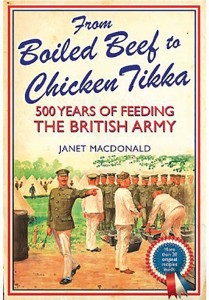Review by Larry S. Sterett | Contributing Editor
FROM BOILED BEEF TO CHICKEN TIKKA, by Janet MacDonald. ©2014. Published by Frontline Books, an imprint of Pen & Sword Books, Ltd., S. Yorkshire, S70 2AS, and distributed in the US by Casemate, Dept. TGM, 908 Darby Road, Havertown, PA 19083 (online: casemategroup.com) Price: $39.95, plus shipping. Available at most web and storefront bookstores.
Following a short note from the author and the usual introduction, this 256-page hardbound volume contains 11 interesting chapters, a conclusion, bibliography, two appendices, some recipes, a glossary, acknowledgements, and an index. The recipes are few in number, scaled down to feed four instead of the original 50 soldiers, and relatively easy to prepare. For hunters, Rabbit Pie and Game Pie represent ways to use what they bag, while Mulligatawny Soup and Corned Beef Wellington are relatively easy to prepare. (As of 2009, corned beef is no longer listed in British Army rations.) The Glossary is brief, but needed to supplement the reader’s vocabulary in case he or she is a newcomer.
 The 11 chapters range from the Early Days—Cromwell and Marlborough’s times—to After the Second World War. Although Napoleon reportedly remarked “an army marches on its stomach,” it’s still true the officers usually eat better than the men who do the fighting. Although today’s MRE’s are better than World War II’s K-rations or survival D-rations, they are not the same as hot chow in the mess hall. This volume tells the story over the decades, but the problem still remains.
The 11 chapters range from the Early Days—Cromwell and Marlborough’s times—to After the Second World War. Although Napoleon reportedly remarked “an army marches on its stomach,” it’s still true the officers usually eat better than the men who do the fighting. Although today’s MRE’s are better than World War II’s K-rations or survival D-rations, they are not the same as hot chow in the mess hall. This volume tells the story over the decades, but the problem still remains.
Many readers who were around during World War II may remember the plastic bag filled with one-pound of what appeared to be lard with a small red-colored capsule inside. You squeezed the capsule to break it and released the food coloring inside, and then massaged the plastic bag until the lard substance (actually a vegetable shortening) was a uniform yellow color resembling butter, and you now had oleo-margarine, commonly shortened to just plain oleo. Something new! Not really. French Emperor Napoleon III had offered a prize to anyone who could produce a satisfactory substitute for butter for the lower classes and military use. A French food chemist, Hippolyte Mege-Mouries, came up with what he called ‘margarine’ composed originally of ingredients including milk, cow’s udder, beef fat and sodium bicarbonate. Later, whale oil was added. In 1902 the discovery in Germany of hydrogenation of unsaturated fat into saturated fat allowed the plant oils to replace the original ingredients. The yellow dye provided a more palatable appearance, and, while it did not taste like butter, it was better than rancid butter that economy-minded military authorities soon introduced into the ration, more than century ago.
Illustrations consist of 16 pages of black and white photographs, some vintage from the early days onward to a modern field kitchen and parachute delivery. (The photo of a horse-drawn Mark X general service wagon used for carrying and issuing food is reminiscent of the chuck wagon used on cattle drives in the American West in the late 1800s.) The photographs illustrating the space and weight reduction gained by using dehydrated food is definitely good information, and that’s prior to freeze-drying. One hundred pounds each of potatoes, onions, and cabbage, were reduced respectively to seventeen, seven, and six pounds. (The major loss was water, naturally, to the amounts of 63, 83, and 66 pounds, respectively.) Today’s backpackers, campers, and camping hunters, in addition to the military, have benefited greatly from military research into feeding service personnel in the field.
This is an interesting and informative tome. From a historical viewpoint the reader can learn what has worked, and what hasn’t, at least so far as the English were concerned. Not many subjects related to 500 Years of Feeding the British Army are missed. Rodent control, skinning and cooking of snakes, officer’s rations vs. those of combat troops, the ‘bromide myth’, food storage and preservation, and much more is covered. Even food prepared according to some of the included recipes proved interesting. (Regardless of individual preferences, US Military chow is still more nutritious and better tasting than that of other military forces.)



